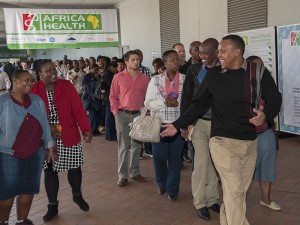This is according to Dr Georges Balenda, Head of the Folang Wound Clinic (FWC), Far East Rand Hospital (FERH) and speaker at the 6th annual Africa Health Exhibition & Congress.

Balenda was also recently appointed as the President of the Wound Healing Association of Southern Africa (WHASA).
Balenda says in order to meet the needs of patients with wounds, there needs to be a focus on developing infrastructure and training healthcare providers in order to be able to provide a specialised service to a region. FWC, which is a centre of excellence in Gauteng, has seen an increase of outpatients from 3,551 in 2013 to 4,907 in 2015 for example.
FWC and FERH are examples of how such facilities can alleviate resource constraints at South African hospitals in terms of both bed space and human resources, while simultaneously providing services at a significantly cheaper cost to both patient and State.
However, Balenda says it is not only about money and that research has shown that patients’ level of comfort is higher when being treated at FWC as compared to hospital visits for wound treatment. Furthermore, wound care facilities also serve as training centres for healthcare workers.
Balenda says some of the challenges facing wound care clinics is patient adherence due to lack of transport and wound overgranulations caused by surgical backlogs.
Wound care, especially regarding foot complications, is crucial as the number of people living with diseases such as diabetes is set to increase, according to the Head of Podiatry at the University of Johannesburg’s (UJ) Faculty of Health Sciences, Professor Simiso Ntuli says.
There are 14.2 million people with diabetes in Africa, with that figure expected to rise to 34.2 million in 2035.
“10 to 15% of these patients will develop foot ulcers at some stage of their lives and nearly 50% of them will be admitted due to diabetic foot complications,” says Ntuli.
He says rapid, accurate foot assessments are vital to treating foot complications, such as wounds, to reduce the number of amputations. Amputations not only have a devastating effect on the patient emotionally and physically but can also lead to difficulties in finding work which, in turn, presents an added cost to the State.
“There is a need for structured foot-health services in Africa. In less developed countries there is a lack of awareness of foot care issues among patients and healthcare practitioners,” Ntuli says.
Ntuli acknowledges that the challenge of a lack of resources often means that healthcare practitioners do not have the time to examine feet among their other workloads. He says this highlights the need for more podiatrists in healthcare facilities, but that nurses should also be given the time and empowerment to be able to identify and refer foot complications accordingly.
Professor Keith Harding, Head of the Wound Healing Research Unit at Cardiff University, says that it has been estimated that a lower limb is amputated every 20 seconds across the world due to complications of diabetes.
He adds that the treatment of diabetic foot complications accounts for 15% to 25% of total healthcare resources for diabetes in the UK’s National Health Service, highlighting the need for preventative foot care to alleviate the allocation of resources.
To achieve greater prevention levels, there needs to be an emphasis on improving testing and diagnostic tools. He says innovations such as temperature mapping for chronic wounds and devices which capture photos of wounds using ultra-violet lights to identify where bacteria is located are exciting, but highlighted that these have yet to be scientifically proven.
He adds that he is also co-working on research to identify gene signatures which may be able to determine if a wound will heal or not, improving the speed and efficacy of the decision making process in wound treatment.
The conference that had over 7000 attendees and 57 States over three-days ends today, reports Karabo Moloi.
